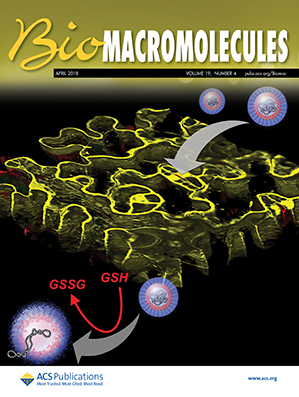pH-Responsive Conformational-Switching Cationic Fusion Protein for Promoted Plasmid DNA Delivery and Transfection
IF 5.4
2区 化学
Q1 BIOCHEMISTRY & MOLECULAR BIOLOGY
引用次数: 0
Abstract
Gene therapy holds great promise for treating various diseases, but challenges such as delivery efficiency, immune response, and long-term effects still remain. Protamine is a frequently used gene delivery vector for its strong nucleic acid binding capacity, but its application is constrained by inadequate nucleic acid release, resulting in low transfection efficiency. Here, we introduce a fusion protein by integrating LAH4 peptides on both ends of protamine’s DNA-binding motif. This fusion protein exhibits lower cytotoxicity compared to protamine. At pH 7.4, its uniform charge distribution and α-helical structure enable robust DNA condensation and DNase resistance. Under acidic conditions (pH 5.8), the conformational change of the protein weakens its DNA binding, facilitating controlled release in endosomes/lysosomes. Simultaneously, it interacts with the endosomal membrane to form pores, aiding in the endosomal escape of the nucleic acids, thereby significantly improving transfection efficiency. This fusion protein offers the potential for efficient and safe nucleic acid delivery.
- Download: Download high-res image (62KB)
- Download: Download full-size image
促进质粒DNA传递和转染的ph响应构象开关阳离子融合蛋白。
基因疗法在治疗各种疾病方面有着巨大的希望,但诸如递送效率、免疫反应和长期效果等挑战仍然存在。鱼精蛋白具有较强的核酸结合能力,是常用的基因传递载体,但其应用受到核酸释放不足的制约,转染效率较低。在这里,我们通过在鱼精蛋白dna结合基序的两端整合LAH4肽引入融合蛋白。与鱼精蛋白相比,这种融合蛋白具有较低的细胞毒性。在pH 7.4时,其均匀的电荷分布和α-螺旋结构使其具有强大的DNA凝聚和抗DNA酶能力。在酸性条件下(pH 5.8),蛋白质的构象变化减弱了其与DNA的结合,促进了内体/溶酶体的控制释放。同时,它与核内体膜相互作用形成孔,帮助核酸在核内体逃逸,从而显著提高转染效率。这种融合蛋白提供了高效和安全的核酸传递的潜力。
本文章由计算机程序翻译,如有差异,请以英文原文为准。
求助全文
约1分钟内获得全文
求助全文
来源期刊

Biomacromolecules
化学-高分子科学
CiteScore
10.60
自引率
4.80%
发文量
417
审稿时长
1.6 months
期刊介绍:
Biomacromolecules is a leading forum for the dissemination of cutting-edge research at the interface of polymer science and biology. Submissions to Biomacromolecules should contain strong elements of innovation in terms of macromolecular design, synthesis and characterization, or in the application of polymer materials to biology and medicine.
Topics covered by Biomacromolecules include, but are not exclusively limited to: sustainable polymers, polymers based on natural and renewable resources, degradable polymers, polymer conjugates, polymeric drugs, polymers in biocatalysis, biomacromolecular assembly, biomimetic polymers, polymer-biomineral hybrids, biomimetic-polymer processing, polymer recycling, bioactive polymer surfaces, original polymer design for biomedical applications such as immunotherapy, drug delivery, gene delivery, antimicrobial applications, diagnostic imaging and biosensing, polymers in tissue engineering and regenerative medicine, polymeric scaffolds and hydrogels for cell culture and delivery.
 求助内容:
求助内容: 应助结果提醒方式:
应助结果提醒方式:


